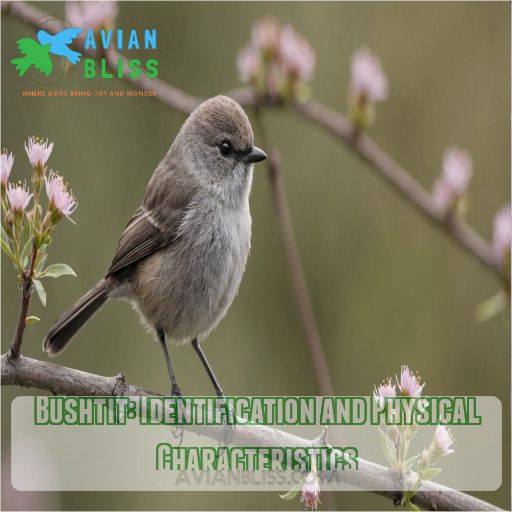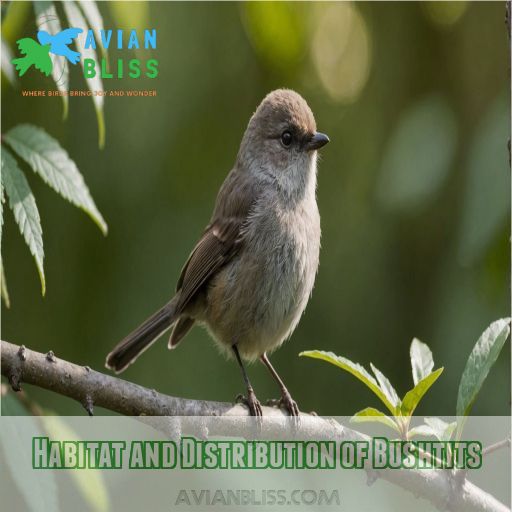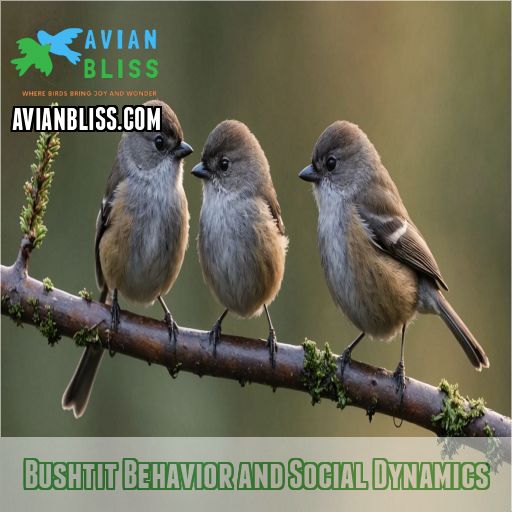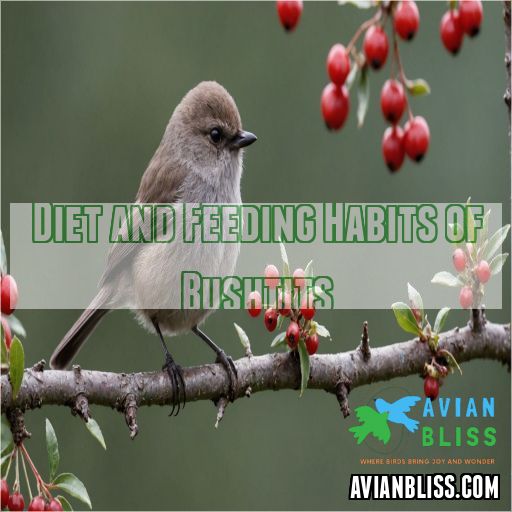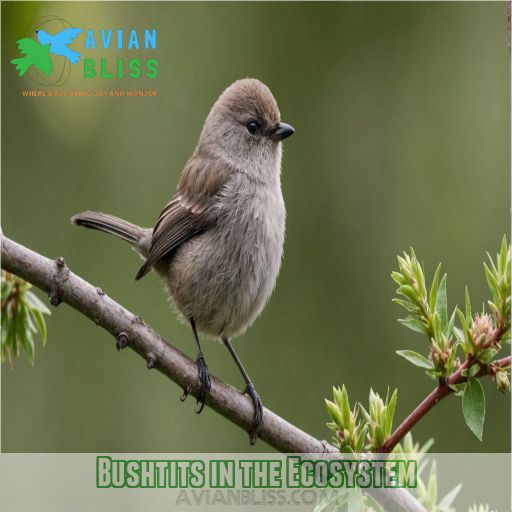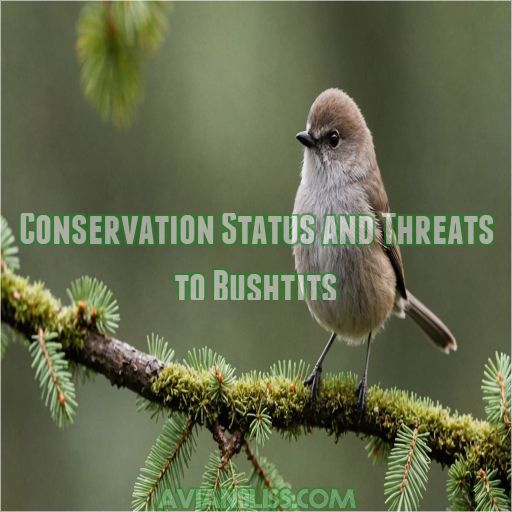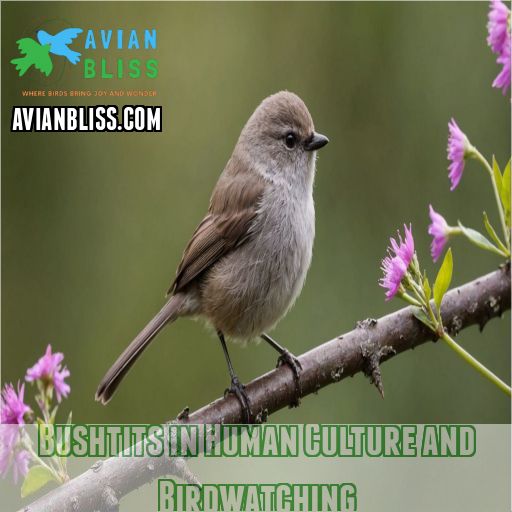This site is supported by our readers. We may earn a commission, at no cost to you, if you purchase through links.
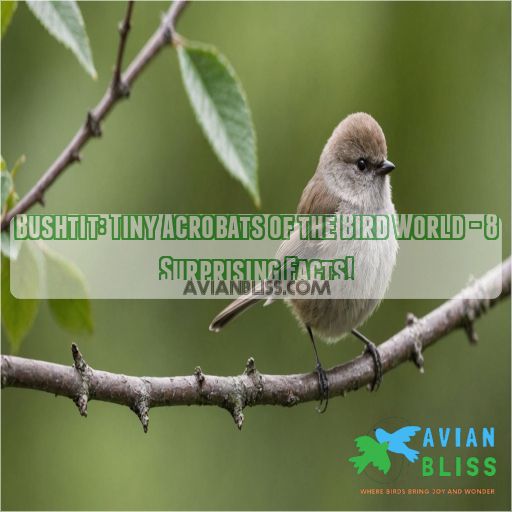
The males have dark eyes, while females sport pale ones—talk about eye-catching! They flit through western u.s. landscapes, from oak forests to chaparral, often moving in a chattering flock of up to 40, like a flying family reunion.
These agile foragers tackle insects, helping control pests while sharing a meal with friends. Building cozy, pocket-like nests, bushtits blend cooperation with charm.
Curious about their role in the ecosystem and conservation status? That’s a story worth exploring!
Table Of Contents
- Key Takeaways
- Bushtit: Identification and Physical Characteristics
- Habitat and Distribution of Bushtits
- Bushtit Behavior and Social Dynamics
- Diet and Feeding Habits of Bushtits
- Bushtit Breeding and Nesting Practices
- Bushtits in the Ecosystem
- Conservation Status and Threats to Bushtits
- Bushtits in Human Culture and Birdwatching
- Frequently Asked Questions (FAQs)
- Why are they called Bushtit?
- Is a Bushtit the same as a titmouse?
- Is a Bushtit a chickadee?
- Where do Bushtit birds live?
- How do bushtits communicate with each other?
- What sounds do bushtits commonly make?
- Can bushtits be kept as pets?
- How long do bushtits live in the wild?
- What unique nesting materials do bushtits use?
- Conclusion
Key Takeaways
- You’ll love how bushtits, those tiny aerial acrobats, come with a palette of browns and grays that blend right into their woodsy backdrops, making them the ninjas of the bird world. Spotting them feels like a small victory each time.
- Don’t underestimate the bushtits’ knack for socializing; these birds are like the chatty family at a reunion, always sticking together in flocks and keeping each other warm during chilly nights. It’s the ultimate avian slumber party.
- These pint-sized birds serve as nature’s pest control by munching through a buffet of insects, helping maintain the delicate balance in their ecosystem, and they might even be deterred by some strong scents. Imagine them as little superheroes with capes made of feathers, swooping in to save your garden.
- While they might remind you of chickadees, bushtits have their own flair, weaving intricate nests with spider webs and moss. It’s like the birds are master architects in the world of tiny homes, crafting the perfect avian apartments.
Bushtit: Identification and Physical Characteristics
You’re about to meet one of nature’s tiniest acrobats – the bushtit.
These pint-sized birds pack a lot of personality into their small frames, and their unique features make them a delight for birdwatchers to spot and identify.
Size and Shape of Bushtits
At first glance, you might mistake a bushtit for a flying cotton ball! These tiny acrobats are truly pint-sized wonders:
- Sparrow-sized body
- Long, slender tail
- Small, delicate bill
- Rounded, fluffy shape
- Lightweight frame
Bushtits are truly a sight to behold.
Plumage Coloration and Patterns
You’ve seen the Bushtit’s tiny size, now let’s explore their feathery fashion! These little birds sport a palette that’d make any camouflage expert jealous:
| Color | Purpose | Where |
|---|---|---|
| Brown | Blend in | Tree bark |
| Gray | Disguise | Branches |
| Tan | Hide | Leaves |
These little birds are masters of blending in with their surroundings.
Distinctive Features of Male and Female Bushtits
While bushtits may seem identical at first glance, there’s more than meets the eye! Let’s explore the subtle differences between males and females:
- Eye color: Females’ pale, males’ dark
- Plumage: Slight variations
- Nesting roles: Shared responsibilities
Differences Between Coastal and Inland Bushtits
Did you know coastal bushtits sport browner heads than their inland cousins? Let’s take a closer look at their differences:
Coastal bushtits and inland bushtits have a few key distinctions.
| Feature | Coastal Bushtits | Inland Bushtits |
|---|---|---|
| Head Color | Browner | Grayer |
| Habitat | Near shorelines | Woodlands |
| Diet | More marine prey | Varied insects |
| Vocalizations | Slightly higher | Lower pitched |
Habitat and Distribution of Bushtits
Now that we’ve seen how to spot these tiny acrobats, let’s explore their preferred hangouts. Bushtits are the social butterflies of the bird world, flitting through various western U.S. habitats like they’re on a grand tour. These pint-sized performers have quite the range:
- Chaparral: Their favorite stage for insect-hunting stunts
- Oak forests: Perfect for their upside-down acrobatics
- Pinyon-juniper woods: A cozy winter retreat
- Pine-oak mixtures: Ideal for building their elaborate nests
- Streamside groves: A cool summer hangout
Bushtits aren’t fans of extreme heights or scorching deserts, preferring the Goldilocks zone of lowlands to mid-elevations. It’s like they’ve found their sweet spot! But watch out – these feathered friends might surprise you with a winter appearance in desert streams, proving they’re always up for a new adventure like the migrating Scoters.
Bushtit Behavior and Social Dynamics
You’re about to discover the fascinating world of bushtit behavior and social dynamics.
These tiny acrobats of the bird world will amaze you with their flocking habits, foraging techniques, and unique roosting behaviors, like the Mountain Chickadee’s social flocks.
Flocking Habits and Social Interactions
You’ll be amazed by bushtits’ social lives!
These tiny birds flock together in large groups, sometimes numbering up to 40 individuals.
They’re constantly chattering and keeping in touch as they move through the trees.
Foraging Techniques and Acrobatic Movements
Watch bushtits perform aerial acrobatics as they forage!
These tiny birds dart through foliage, hanging upside down from twigs to snatch insects.
Their agile maneuvers in flocks are a sight to behold.
Roosting Behavior in Cold Weather
When temperatures plummet, bushtits showcase their social side.
These tiny birds huddle together in tight, cozy masses during chilly nights.
It’s like a feathery slumber party that helps them conserve precious body heat!
Seasonal Movements and Migration Patterns
While most bushtits aren’t long-distance migrants, some flocks set out on short journeys.
They’ll venture into lowlands during winter, seeking milder climes and better foraging opportunities.
These tiny travelers adapt to seasonal changes with remarkable flexibility.
Diet and Feeding Habits of Bushtits
You might think these tiny birds are picky eaters, but bushtits have quite the appetite for a variety of insects.
Their diet and feeding habits reveal fascinating adaptations that make them skilled hunters and important players in natural pest control.
Primary Insect Prey Species
You’ll be amazed by bushtits’ diverse menu!
These tiny acrobats feast on leafhoppers, treehoppers, aphids, and scale insects.
They’re also partial to caterpillars, beetles, wasps, and ants.
Talk about an insect smorgasbord!
Foraging Strategies and Techniques
Bushtits are nature’s tiny acrobats, showcasing impressive foraging techniques. These energetic birds employ a variety of strategies to snag their meals:
- Hanging upside-down from twigs
- Rapidly hopping between branches
- Probing bark crevices
- Fluttering mid-air to catch flying insects
Bushtits are small, active birds with a unique feeding style.
Seasonal Variations in Diet
Ever wonder what bushtits eat when insects are scarce?
These resourceful little birds adapt their menu with the seasons.
In winter, they’ll snack on berries and seeds, while spring brings a buffet of juicy caterpillars.
Role of Bushtits in Pest Control
Did you know these tiny birds are nature’s pest control experts?
By devouring countless insects daily, bushtits act as living insecticides, protecting your garden and local ecosystems from potential infestations.
Talk about small but mighty!
Bushtit Breeding and Nesting Practices
Among bushtits, lovebirds work together to build a snug little nest that’s a real architectural wonder, using all sorts of crafty materials like spiderwebs and moss.
You’ll be charmed to know these tiny architects share the job of incubating their eggs but also team up to care for their fledgling family, showing parental dedication that rivals any sitcom duo.
Courtship and Pair Bonding
Shifting from dining habits, imagine this: in spring, Bushtit courtship displays include quick chases and dainty dances, while whispering sweet nothings.
These bonding rituals highlight their commitment and strengthen pair fidelity.
Nest Construction and Materials
Now that pair bonding’s handled, let’s peek at bushtit nest design!
They weave hanging pocket nests using spiderwebs, grass, and feathers.
Busy little homemakers, aren’t they?
Watch for sneaky nest predators too!
Egg Laying and Incubation
Bushtits use strategic nest site selection and lay around five to seven small eggs. Things to note:
- Egg coloration: white.
- Incubation period: 12–13 days.
- Both parents involved.
Parental Care and Fledgling Development
Once the eggs hatch, both parents diligently feed the hungry nestlings, ensuring their rapid growth.
As the fledglings gain independence, the devoted parents continue guiding and protecting them until they can thrive on their own.
Bushtits in the Ecosystem
You’ll find that bushtits are small but mighty players in their ecosystems, interacting with other birds and controlling insect populations.
Seed dispersal is also supported by their cheeky antics in foraging, making them essential to the health of their habitats.
Interactions With Other Bird Species
Amidst the hustle and bustle of mixed-species flocks, these sociable little bushtits have a knack for cooperative breeding.
They often resolve territorial disputes amicably, maintaining harmony while dealing with the challenges of interspecies competition.
Predators and Defensive Strategies
As bushtits charmingly mingle with other birds, life’s a dance with predators too.
They strengthen flock cohesion using defensive calls, enacting mobbing behavior against threats.
Predator avoidance becomes their acrobatic art, balancing freedom and survival.
Impact on Insect Populations
Bushtits play a key role in regulating insect populations, acting as natural pest controllers in their woodland habitats. Their voracious appetite for a variety of insects helps maintain ecological balance.
Role in Seed Dispersal
Imagine a tiny bird helping nature with seed dispersal! By munching on berries, bushtits partake in frugivory, which aids their diet and helps seeds remain viable, positively impacting the ecosystem.
Conservation Status and Threats to Bushtits
You’ll find bushtits all around your favorite forests yet they face challenges like habitat loss and climate change.
Keep reading to uncover how these tiny acrobats adapt and what’s being done to help their vibrant flocks continue to entertain us.
Current Population Trends
If you’ve ever watched bushtits flit about, you might wonder how they’re doing.
Their numbers fluctuate due to breeding success and climate change.
Thankfully, ongoing conservation efforts help counter potential population declines.
Habitat Loss and Fragmentation
Habitat loss and fragmentation pose grave threats, as Bushtit populations dwindle in the face of vanishing woodlands and encroaching urbanization. Restoring connected, thriving forests is essential for their survival.
- Deforestation and land development fragment Bushtit habitats.
- Urbanization and sprawl destroy critical nesting and foraging areas.
- Invasive species outcompete native plants, disrupting Bushtit food webs by creating a bird-friendly habitat.
- Lack of protected corridors limits Bushtit movement and gene flow.
Climate Change Impacts
Bushtits face threats from climate change impacting their range shifts, food availability, and nesting season shifts. Just as you adapt to life’s curveballs, these tiny birds juggle survival challenges.
Conservation Efforts and Protections
As climate change affects their environment, you can support Bushtits through conservation efforts.
Consider joining citizen science projects to track population trends and address habitat loss, ensuring these birds continue their acrobatics.
Bushtits in Human Culture and Birdwatching
Although bushtits might lack bright colors, they’ve certainly found a soft spot in birdwatchers’ hearts with their playful nature and unique hanging nests.
Whether you’re watching them flit around your yard or participating in citizen science projects that track these tiny acrobats, you can’t help but be charmed by their sociable antics.
Native American Folklore and Traditions
Weaving Bushtit lore into Native traditions, these tiny birds hold symbolic meaning, with tribes crafting intricate stories and rituals honoring their acrobatic presence in the wild.
Popularity Among Birdwatchers
You’re in for a treat with bushtits—tiny yet fascinating!
Birdwatchers love their sociable flocks and playful antics.
Spot them by their constant chatter and energetic, acrobatic feats among the foliage.
Attracting Bushtits to Backyard Habitats
To welcome bushtits, consider habitat design with varied planting choices.
Install bushtit feeders and provide fresh water sources.
Use nest boxes to create a cozy haven, inviting these delightful tiny acrobats!
Citizen Science Projects Involving Bushtits
Joining citizen science projects lets you help monitor Bushtits by mapping their range, observing nest activity, and tracking population trends.
Here are four ways to get involved:
- Nest Monitoring
- Foraging Behavior Studies
- Transect Surveys
- Online Data Submissions
Frequently Asked Questions (FAQs)
Why are they called Bushtit?
Ah, the bushtit – a diminutive delight that earns its moniker from its cozy, bush-like nests.
These feathered friends‘ penchant for snug, spherical abodes is the key to their charming nickname, don’t you reckon?
Is a Bushtit the same as a titmouse?
Nope, a Bushtit isn’t the same as a Titmouse.
Bushtits are tiny, social songbirds from western North America,
while Titmice, like the Tufted Titmouse, belong to a different genus and inhabit various North American regions .
Is a Bushtit a chickadee?
You might think Bushtits are chickadees thanks to their small size and busy behavior, but they differ from chickadees in coloration and habitat.
Bushtits are often found in the western U.S. among flocks instead (Source).
Where do Bushtit birds live?
Just like a secret club, these tiny birds hang out in the wooded areas of the western United States.
You’ll find them enjoying lowland forests, chaparral, and pine-oak woods, avoiding high peaks and scorching deserts.
How do bushtits communicate with each other?
Bushtits communicate through a variety of soft, twittering calls to stay in touch with their flock as they forage actively through the foliage.
They also use these calls to coordinate their movements and alert others to potential threats.
What sounds do bushtits commonly make?
In a crowded forest, their tiny voices spring to life—sharp chips and soft tsee notes echo like nature’s music.
These calls, while subtle, weave an essential web of kinship and teamwork amongst their flocks.
Can bushtits be kept as pets?
Keeping these small, lively birds as pets isn’t a good idea.
They’re wild creatures who thrive in social flocks, enjoying the freedom of trees.
Captivity would clip their wings, literally and metaphorically, snuffing out their vivid spirit.
How long do bushtits live in the wild?
Picture flocks of these tiny, energetic birds flitting about—imagine the freedom!
In the wild, they typically live up to six years.
It’s a short life, but packed with adventure and sociable flocks.
What unique nesting materials do bushtits use?
You’ll be amazed by the bushtit’s crafty nest-building skills!
These tiny birds weave together spiderwebs, moss, and even animal hair to create a cozy, hanging pocket.
This pocket is both sturdy and stylish.
Conclusion
Picture a lively flock of bushtits flitting effortlessly through the trees, their endless chatter a sign of their social bonds.
These tiny acrobats not only charm with their playful antics but also play a key ecological role by controlling pests and dispersing seeds.
Whether you’re a birdwatcher capturing their essence or a nature enthusiast admiring their community spirit, bushtits engage imaginations and brighten ecosystems.
Don’t overlook these feathered wonders in your next outdoor adventure!

